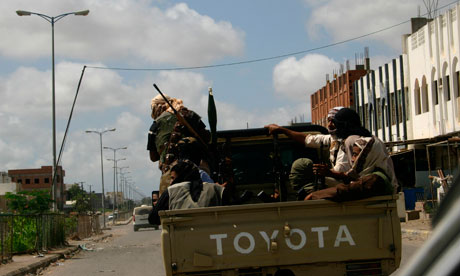I'm quoted in the following article by the Guardian's Jason Burke:
http://www.guardian.co.uk/world/2012/apr/30/al-qaida-threat-analysis
http://www.guardian.co.uk/world/2012/apr/30/al-qaida-threat-analysis
Al-Qaida threat declines in global scope
Osama bin Laden group no longer unifying force it once was as jihadist movement fragments and ambitions become localised

Yemeni militants, suspected of being members of al-Qaida in the Arabian Peninsular, patrol Zinjibar, a city in Abyan province, on Saturday. Photograph: AFP/Getty Images
For those in the counter-terrorist community with long memories, the tape was an unwelcome dose of nostalgia.
From the north African group calling itself al-Qaida in the Islamic Maghreb (AQIM) and uploaded to militant websites last week, it called on Algerians to revolt against the ruling elite and boycott next month's parliamentary election, describing the vote as "plastic surgery".
"O Muslims, your duty today is not to participate in this disgraceful, fake election; your duty is to reject those oppressors in disguise and wage jihad and rise up against them," it said.
Long before Osama bin Laden burst on to the international scene with attacks on US embassies in 1998, it was Algerian militants waging a bloody war against the corrupt, inefficient and broadly secular government who had the fiercest reputation among the many extreme Islamist groups engaged in violent activity at the time. Brewing for years, the conflict in the north African state flared after the Algerian military cancelled an election Islamists were poised to win in 1992.
As analysts try to make sense of the fragmented and chaotic world of militancy following the death of Bin Laden, some are remembering the 1990s. The logic is simple: he and al-Qaida exerted a unifying influence on an otherwise diverse and varied movement. With the core of al-Qaida weaker than it has been for many years, its centralising effect has now gone.
The result, despite an overlay of global rhetoric, is a return to the free-for-all of the pre-Bin Laden era.
Violent extremists, and their sympathisers, are present in almost every country from Morocco to Indonesia, from Uzbekistan to Tanzania. But only in a few are there even semi-organised groups and these rarely have more than a few hundred members.
The exception are four major al-Qaida "affiliates" – al-Qaida in Iraq(AQAI), al-Shabaab in Somalia, the Yemen-based al-Qaida in the Arabian Peninsula (AQAP) and AQIM. There are also concerns aboutBoko Haram in Nigeria and several Pakistani groups, though whether any of these have either genuine links to al-Qaida or serious international ambitions is unclear.
AQAI is seen as having a largely sectarian agenda, representing disgruntled Sunni Muslim communities against Iraq's majority Shia population, with a strong criminal element. AQAI is seen as a potential threat to Iraqi stability but not to that of neighbouring countries. It is also believed to have almost no contact with the remains of the al-Qaida senior leadership in Pakistan.
The danger posed by al-Shabaab depends on an internal struggle between militant leaders who see the battle for control of Somalia as part of an international struggle and those who cleave to a purely local agenda. The threat to the west comes from young volunteers making their way to the battle zone in east Africa and coming back to the UK. This is happening but numbers are tiny.
Probably the most powerful affiliate is in Yemen, though where al-Qaida activity stops and tribal or ethnic activity starts is difficult to say. Here the threat to the west is evident: AQAP has launched a series of bomb plots or other conspiracies against the west and a highly skilled bombmaker is still active, according to western security officials.
That is a logic behind Washington's decision to increase drone attacks.
The wild card is AQIM. Political upheavals in Libya, Algeria and states such as Mali have offered new opportunities for what was a ramshackle network of fragmented groups who used Islamist ideology as a cover for banditry. But whether the threat will become more concrete is less clear. The group remains opportunist, finding space around the edges of Arab uprisings but not more.
There are two major differences with the 1990s. The first is the spread of the ideology and narrative of global jihad over recent decades. The second is the lack of popular support for the groups.
In Algeria, they remain confined to the remotest areas of the country with almost no broad popular support, says Camille Tawil, a London-based journalist and expert on the group. The same is true in varying degrees elsewhere.
Indeed, a glance at the map reveals that the various affiliates are still broadly restricted to the periphery of the Islamic world in geographical terms – a useful visual manifestation of their overall social, ideological, cultural and political marginalisation too.

No comments:
Post a Comment